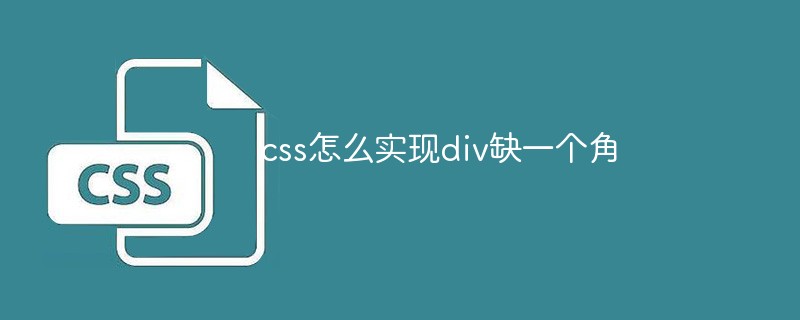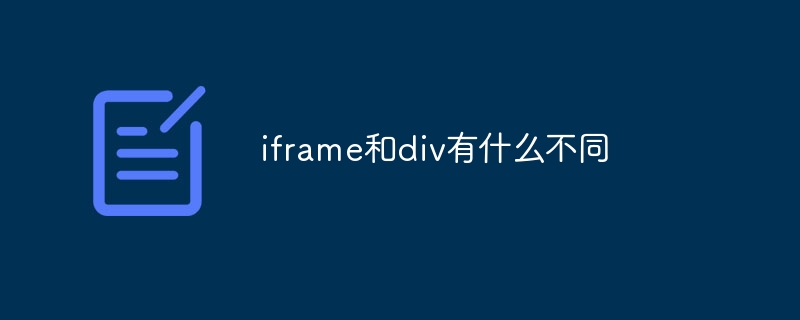The differences are: 1. div is a block-level element, and span is an inline element; 2. div will automatically occupy a line, while span will not automatically wrap; 3. div is used to wrap larger structures and In layout, span is used to wrap text or other inline elements; 4. div can contain other block-level elements and inline elements, and span can contain other inline elements.

div and span are two common container tags in HTML. They are used to organize and wrap content in web pages, but there are some differences in their use. .
Tag types and semantics:
div is a block-level element, it is a general container and has no specific semantics. It is often used to organize a related piece of content together, such as the main section of a page or a stand-alone module. The default behavior of a div is to occupy one line and wrap automatically.
span is an inline element. It is also a general container and has no specific semantics. It is usually used to wrap text or other inline elements so that they can be controlled through CSS styles.
Default style:
divs and spans do not have any styles by default, they are just simple containers. The div will automatically occupy one line, and the width defaults to 100% of the parent container. Span will not wrap automatically, and the width defaults to the width of the content.
Applicable scenarios:
Since div is a block-level element, it is usually used to wrap larger structures and layouts, such as the head of a web page, navigation bar, Sidebars, footers, etc. divs can be laid out and beautified by setting CSS style attributes such as width, height, border, and background color.
Span is an inline element, which is usually used to wrap text or other inline elements to facilitate their style adjustment and control. span is usually used to set font color, font size, bold text, italic text, etc.
Nesting relationship:
div can contain other block-level elements and inline elements, such as p, h1-h6, ul, li, etc., and can also contain other divs . divs can be nested within other block-level elements, but not within p tags.
Span can contain other inline elements, such as a, strong, em, etc., and can also contain other spans. Spans can be nested within other inline elements or within block-level elements.
In general, div and span are two common HTML tags used to wrap and organize content. div is a block-level element, usually used to wrap larger structures and layouts, while span is an inline element, usually used to wrap text or other inline elements. They have some differences in default styles, applicable scenarios and nesting relationships. Developers can choose which tag to use based on specific needs.
The above is the detailed content of What are the differences between div and span?. For more information, please follow other related articles on the PHP Chinese website!
 css怎么实现div缺一个角Jan 30, 2023 am 09:23 AM
css怎么实现div缺一个角Jan 30, 2023 am 09:23 AMcss实现div缺一个角的方法:1、创建一个HTML示例文件,并定义一个div;2、给div设置宽高背景色;3、给需要删除一角的div增加一个伪类,将伪类设置成跟背景色一样的颜色,然后旋转45度,再定位到需要去除的那个角即可。
 基于 ChatGPT API 的划词翻译浏览器脚本实现May 01, 2023 pm 03:28 PM
基于 ChatGPT API 的划词翻译浏览器脚本实现May 01, 2023 pm 03:28 PM前言最近GitHub上有个基于ChatGPTAPI的浏览器脚本,openai-translator,短时间内star冲到了12k,功能上除了支持翻译外,还支持润色和总结功能,除了浏览器插件外,还使用了tauri打包了一个桌面客户端,那抛开tauri是使用rust部分,那浏览器部分实现还是比较简单的,今天我们就来手动实现一下。openAI提供的接口比如我们可以复制以下代码,在浏览器控制台中发起请求,就可以完成翻译//示例constOPENAI_API_KEY="s
 div盒模型是什么Oct 09, 2023 pm 05:15 PM
div盒模型是什么Oct 09, 2023 pm 05:15 PMdiv盒模型是一种用于网页布局的模型,它将网页中的元素视为一个个矩形的盒子,这个模型包含了四个部分:内容区域、内边距、边框和外边距。div盒模型的好处是可以方便地控制网页布局和元素之间的间距,通过调整内容区域、内边距、边框和外边距的大小,可以实现各种不同的布局效果,盒模型也提供了一些属性和方法,可以通过CSS和JavaScript来动态地改变盒子的样式和行为。
 div与span的区别有哪些Nov 02, 2023 pm 02:29 PM
div与span的区别有哪些Nov 02, 2023 pm 02:29 PM区别有:1、div是一个块级元素,span是一个行内元素;2、div会自动占据一行,span则不会自动换行;3、div用于包裹比较大的结构和布局,span用于包裹文本或者其他行内元素;4、div可以包含其他块级元素和行内元素,span可以包含其他行内元素。
 iframe和div有什么不同Aug 28, 2023 am 11:46 AM
iframe和div有什么不同Aug 28, 2023 am 11:46 AMiframe和div的不同是iframe主要用于引入外部内容,可以加载其他网站的内容或将一个网页分割成多个区域,每个区域有自己的独立的浏览上下文,而div主要用于分割和组织内容的区块,用于布局和样式控制。
 如何将两个div并排显示Nov 01, 2023 am 11:36 AM
如何将两个div并排显示Nov 01, 2023 am 11:36 AM方法有:1、将两个div元素设置为“float:left;”属性;2、使用CSS的flex布局可以轻松实现元素的并排显示;3、使用CSS的grid布局也可以实现元素的并排显示。
 jQuery技巧:掌握在div中添加标签的方法Feb 23, 2024 pm 01:51 PM
jQuery技巧:掌握在div中添加标签的方法Feb 23, 2024 pm 01:51 PM标题:jQuery技巧:掌握在div中添加标签的方法在网页开发中,经常会遇到需要动态添加标签到页面中的情况。使用jQuery可以方便地操作DOM元素,实现快速的标签添加功能。本文将介绍如何使用jQuery在div中添加标签的方法,并附上具体的代码示例。1.准备工作在使用jQuery之前,需要在页面中引入jQuery库,可以通过CDN链接引入,也可以下载到本
 css div内容超出隐藏怎么实现Jan 28, 2023 pm 03:12 PM
css div内容超出隐藏怎么实现Jan 28, 2023 pm 03:12 PMcss div内容超出隐藏的实现方法:1、通过css代码“overflow: hidden;”实现内容超出隐藏;2、通过js代码“var myBox = document.getElementById('demo');var mydemoHtml = myBox.innerHTML.slice(0, 20) +'......';”实现内容超出隐藏即可。


Hot AI Tools

Undresser.AI Undress
AI-powered app for creating realistic nude photos

AI Clothes Remover
Online AI tool for removing clothes from photos.

Undress AI Tool
Undress images for free

Clothoff.io
AI clothes remover

AI Hentai Generator
Generate AI Hentai for free.

Hot Article

Hot Tools

SAP NetWeaver Server Adapter for Eclipse
Integrate Eclipse with SAP NetWeaver application server.

PhpStorm Mac version
The latest (2018.2.1) professional PHP integrated development tool

DVWA
Damn Vulnerable Web App (DVWA) is a PHP/MySQL web application that is very vulnerable. Its main goals are to be an aid for security professionals to test their skills and tools in a legal environment, to help web developers better understand the process of securing web applications, and to help teachers/students teach/learn in a classroom environment Web application security. The goal of DVWA is to practice some of the most common web vulnerabilities through a simple and straightforward interface, with varying degrees of difficulty. Please note that this software

SublimeText3 English version
Recommended: Win version, supports code prompts!

ZendStudio 13.5.1 Mac
Powerful PHP integrated development environment






